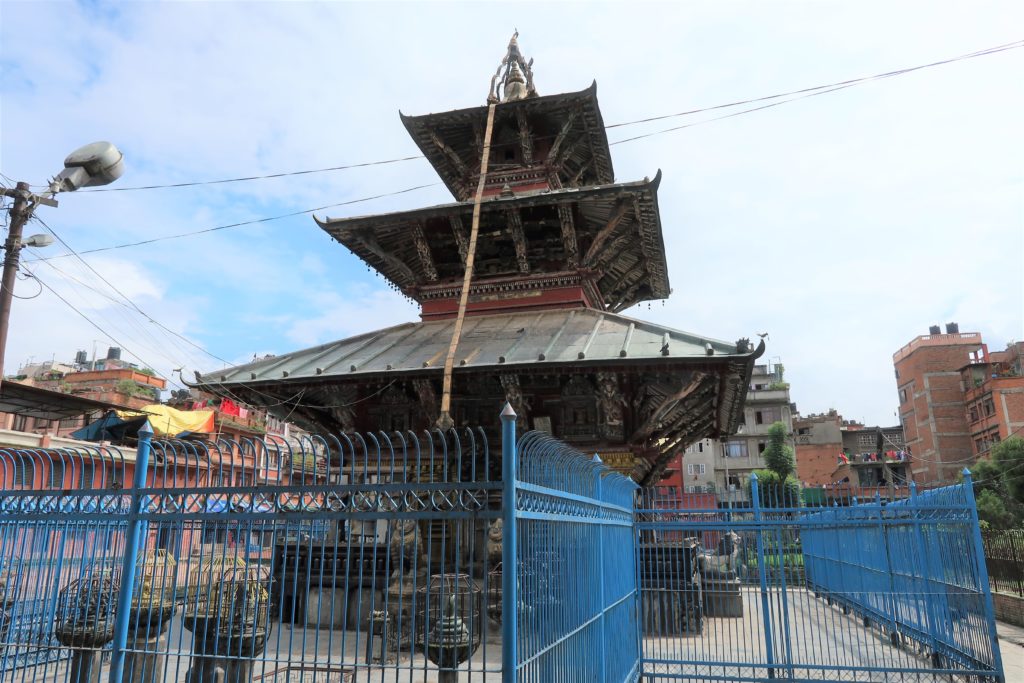カトマンズ Kathmandu ではセト Seto(白)、パタン Patan ではラト Rato(赤)の、雨の神様でもある マチェンドラナート Machhendranath (Matsyendranath) は、ヒンズー教徒にとってはシバ神、仏教徒にとっては観音菩薩(観自在菩薩)の化身です。Rato Machhendranath は、パタンの Machhendranath Temple で年に6ヶ月ほど祀られ、4月から始まる盛大なお祭り”the chariot festival of Rato Matsyendranath” の際に、山車に乗って市内を練り歩き、ブンガマティ Bungamati の Machhendranath Temple に移されます。まずはパタンの方を訪れました。
Lonely Planet による Rato Machhendranath Temple の記事では、
Set inside a protective metal fence, the towering three-storey temple dates from 1673, but there has been some kind of temple on this site since at least 1408. The temple’s four ornate doorways are guarded by stone snow lions, and at ground level on the four corners of the temple plinth are yeti-like demons known as kyah.
Mounted on freestanding pillars at the front of the temple is a curious collection of metal animals in protective cages, including a peacock, Garuda, horse, buffalo, lion, elephant, fish and snake. Look up to see the richly painted roof struts of the temple, which show Avalokiteshvara standing above figures being tortured in hell.
と紹介されています。 柵で囲まれ、もっと近くで見れないのが残念ですが、
柵で囲まれ、もっと近くで見れないのが残念ですが、
確かに扉はSnow Lionに守られ、建物の彫刻は美しいものです。 是非ともお祭りも見てみたいものです。詳細が ECS NEPAL の 「Rato Matsyendranath 」の記事で紹介されています。お祭りと言えば、家族や親族が集い食事などを楽しむ機会でもあり、同記事のなかでも
是非ともお祭りも見てみたいものです。詳細が ECS NEPAL の 「Rato Matsyendranath 」の記事で紹介されています。お祭りと言えば、家族や親族が集い食事などを楽しむ機会でもあり、同記事のなかでも
At every place where the chariot takes a rest, there is a celebration called a Bhujya. Newari people, renowned for their extravagant feasts, use this auspicious occasion for organizing an informal get-together called a Nakhtya. The day before the Bhujya celebration is known as Chhwela Bu, where chhwela. a popular beef delicacy, is prepared by the Newars and enjoyed by most non-vegetarians.
との記述があります。Nakhtya (Nakhatya) で検索すると、ECS NEPAL の「A big, fat, Newari Nakhatya 」の記事の中でも、the chariot festival of Rato Matsyendranath が登場しています。
In olden days and as is still the case, a Nakhatya would follow any major festival in the Kathmandu valley. Anyone familiar to the generous sprinkling of festivals on the Nepali calendar will agree that this makes up for many get-togethers. Take the chariot festival of Rato Matsyendranath as an example. During this festival, each community in the valley has its own chhwela bu, naika luigu, bhujya and yaka bhujya rituals when the chariot reaches their locality. The ‘bhujya’ ritual of the festival is celebrated after the ‘naika luigu’ ritual; the former marks the arrival of the chariot into their neighborhood and is celebrated with family gatherings and feasts. As the chariot makes its round, the get-togethers (read: feasts) follow.
お祭りに関する食事の儀式がいろいろあるようです。

「Rato Machhendranath Temple ラトマチェンドラナート寺院 (Patan)」への1件のフィードバック
コメントは受け付けていません。